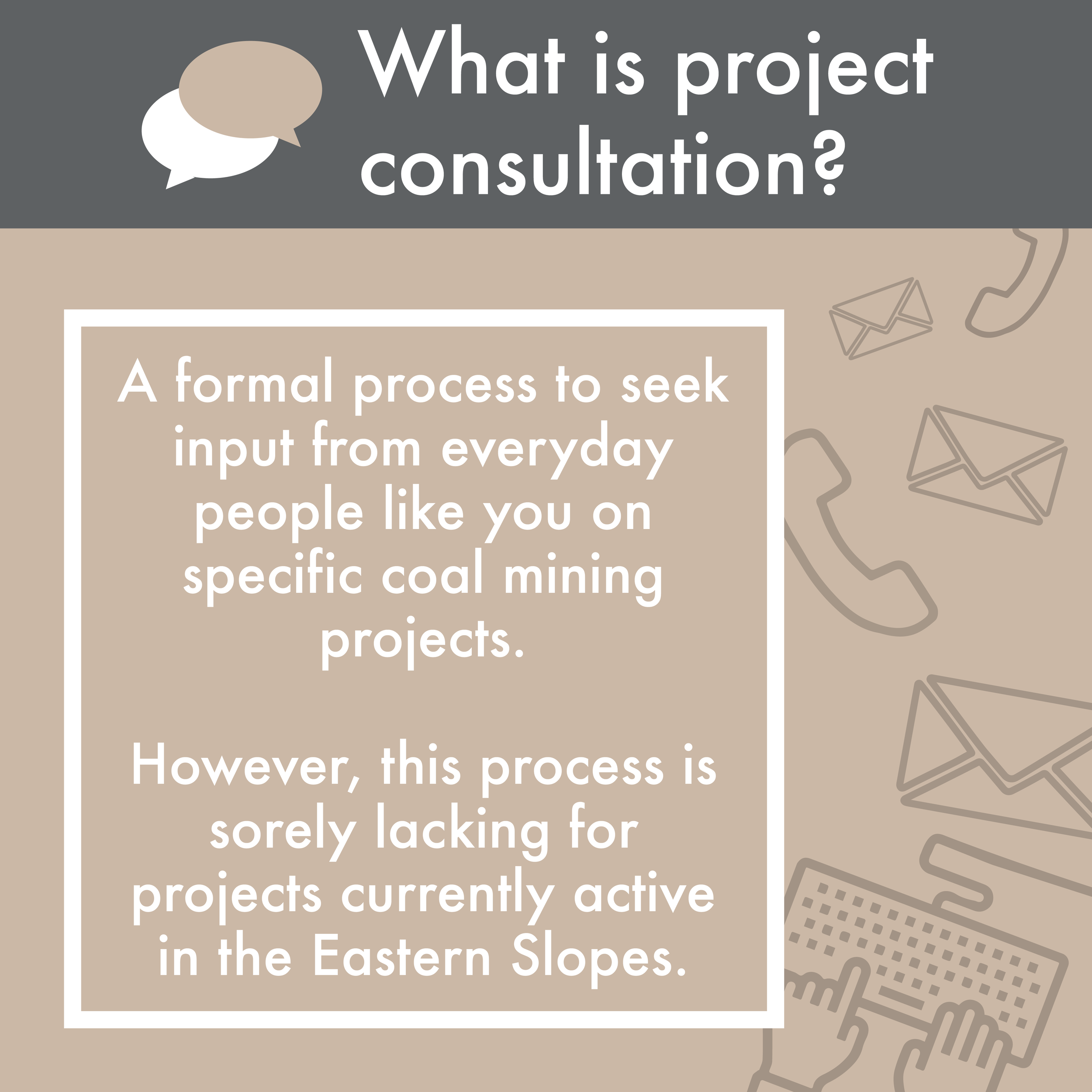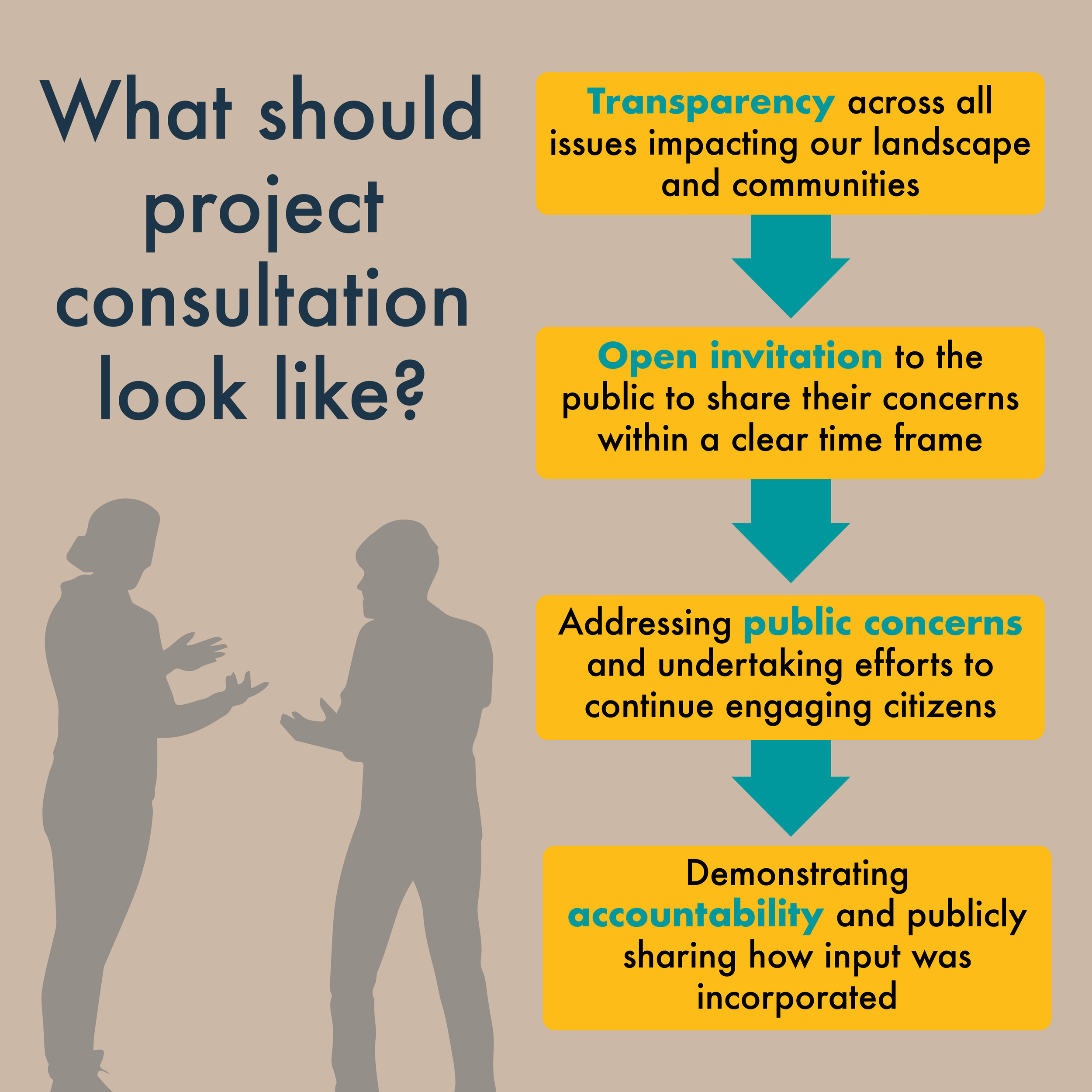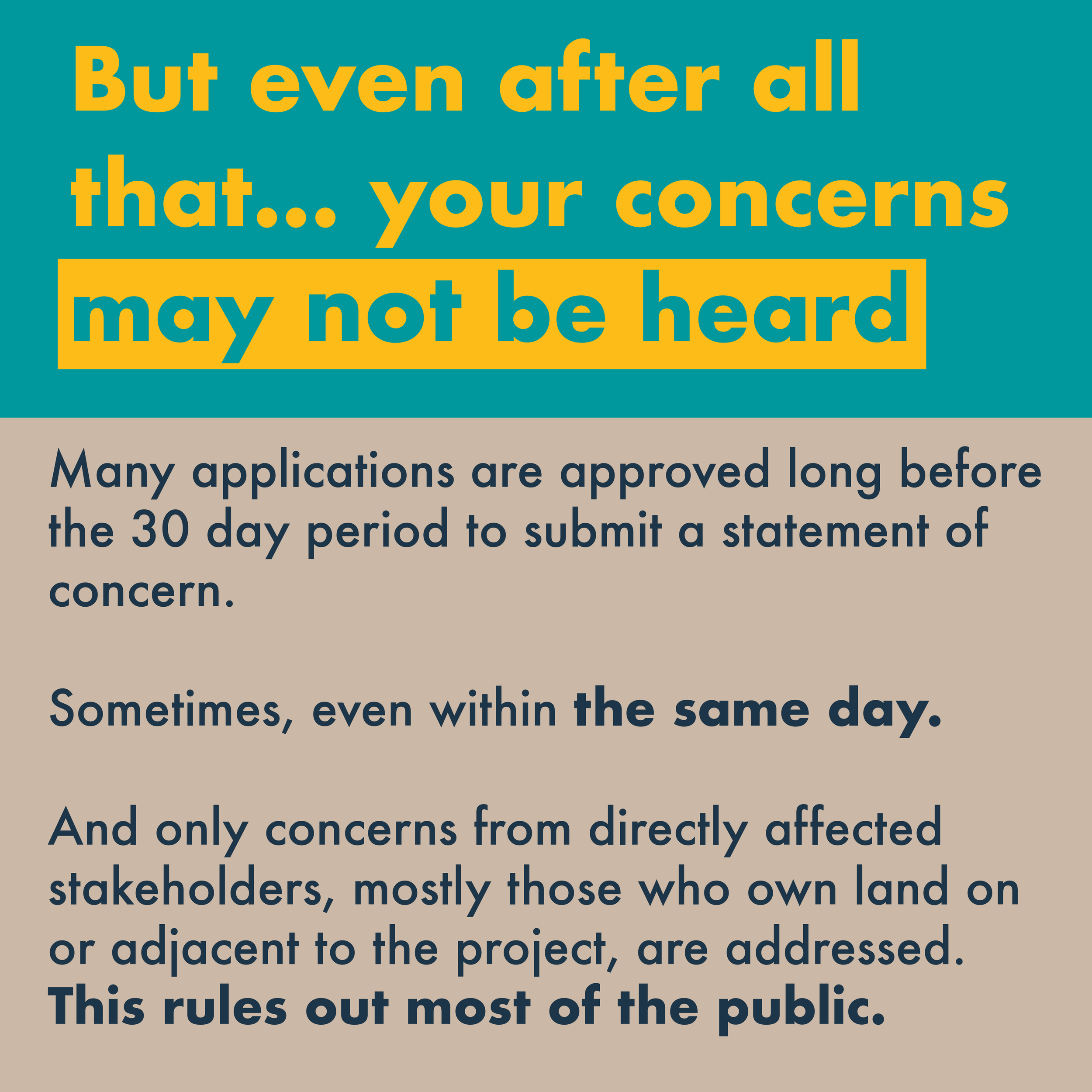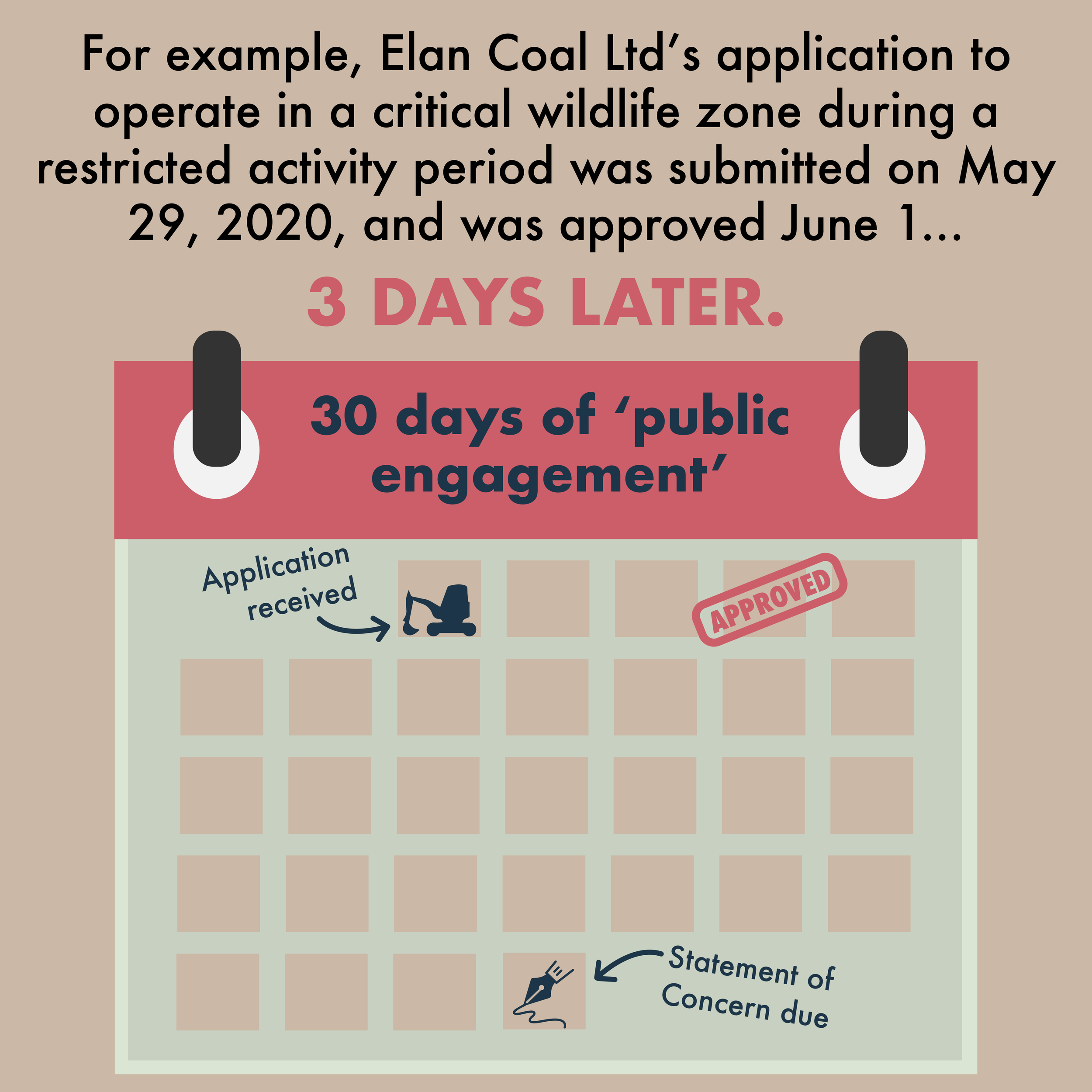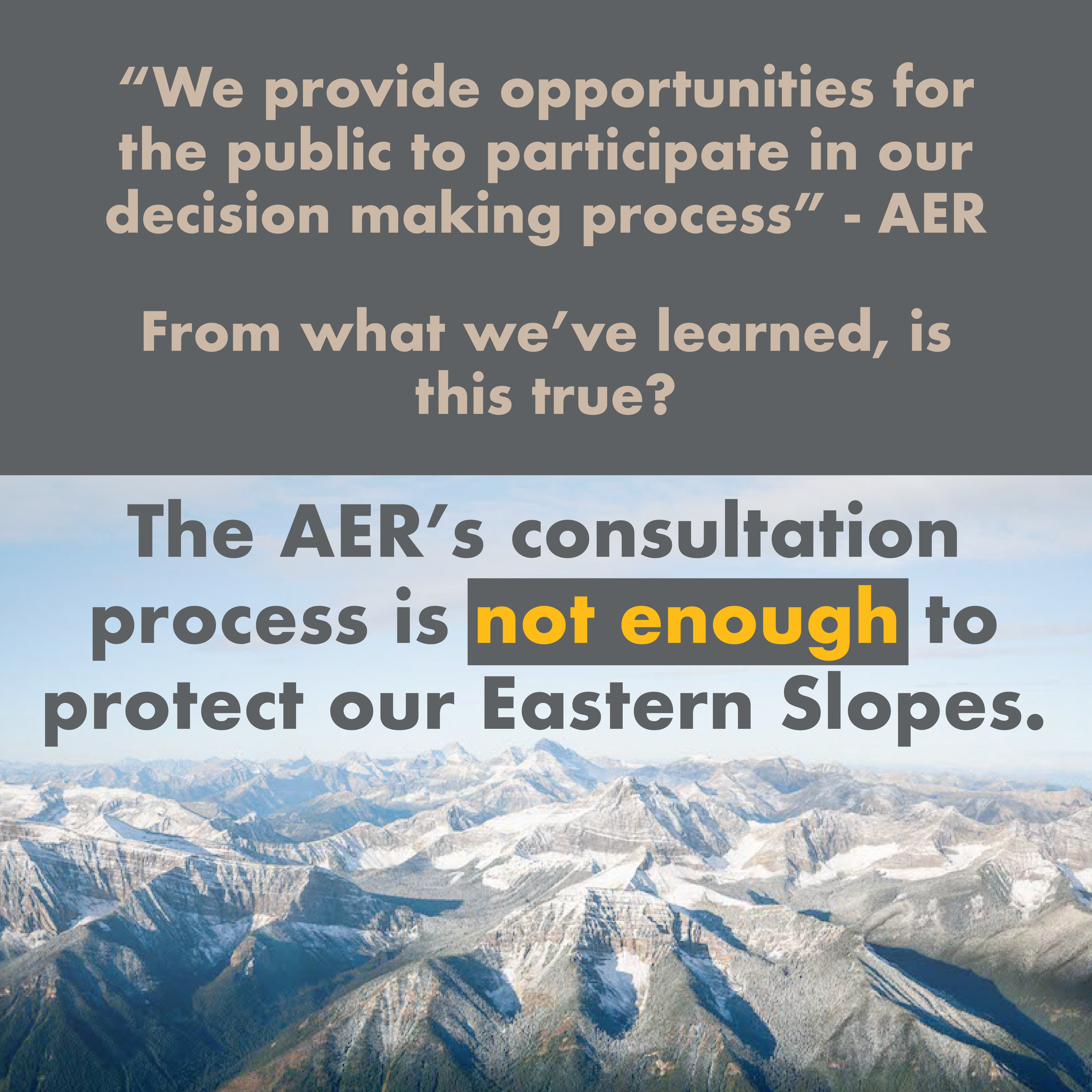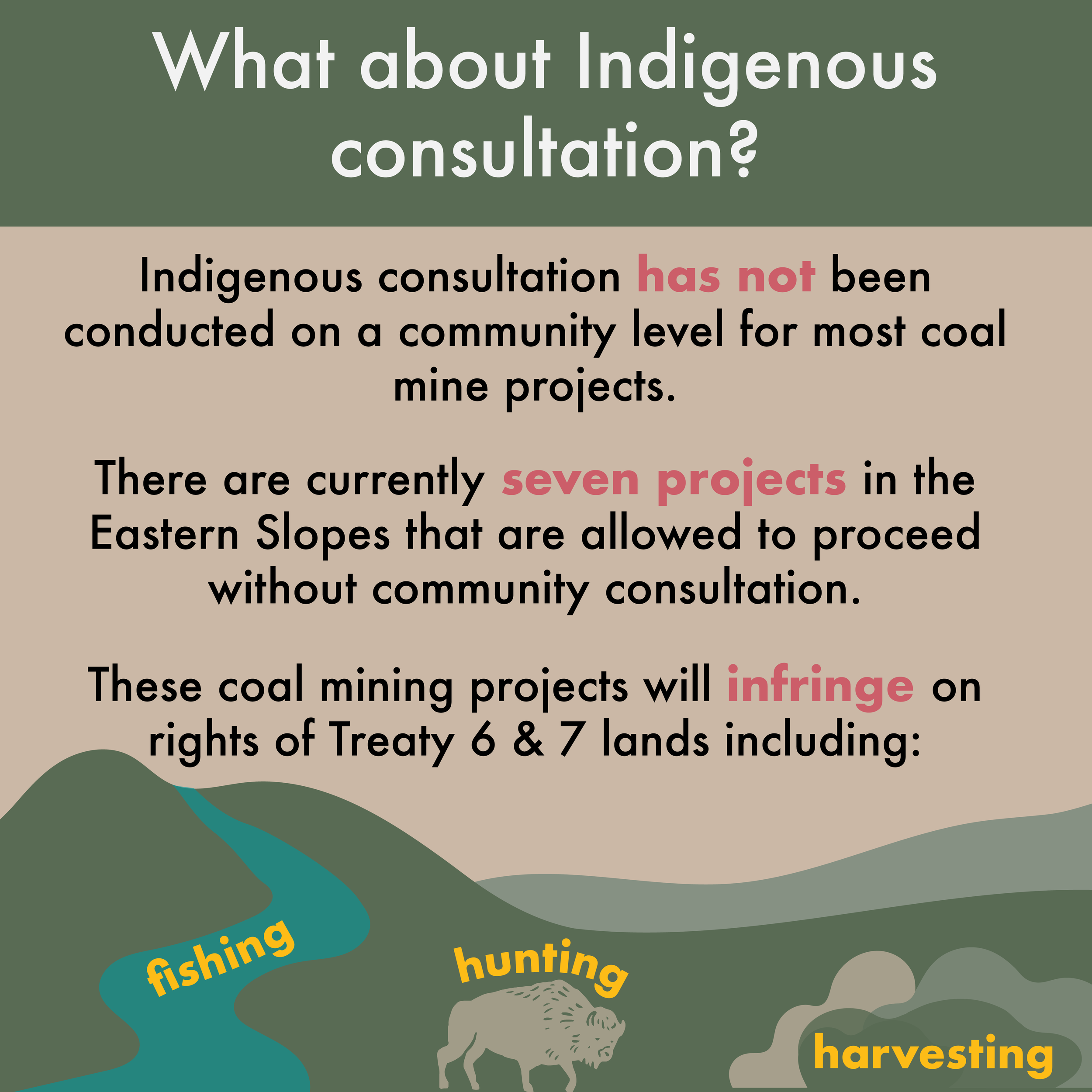Life of a Mine Part 1 - Consultation
In this series we’re going to take you from start to finish through the life of an open-pit coal mine in Alberta. Keep reading below to lean about how project and exploration consultation occurs, or click on one of the stages below to learn more.
How is coal exploration approved? Deciphering AER’s “public” project consultation process.
Despite the reinstatement of the Coal Policy in February, coal exploration activity such as drilling and road construction is moving ahead. Currently there are hundreds of new drill sites and over 200km of new exploratory roads approved for construction in southwest Alberta alone. This increase in industrial footprint was approved with little public awareness or input. Elected officials often reference the many opportunities for public engagement through the Alberta Energy Regulator (AER). However, the reality of engaging in coal development even at the exploration phase is often more complicated than they let on.
Coal companies can apply for an exploration permit on lands for which they have a Coal Lease Agreement or own the freehold coal rights. Coal leases grant exclusive rights to coal under a section of land and are granted by Alberta Energy for a 15-year renewable term. The application and coal leasing process does not consider environmental concerns, and there is normally little to no opportunity for public participation in the granting of leases. There are approximately 600,000 hectares of leases across the Eastern Slopes, almost one third of which were granted between the rescission and the reinstatement of the Coal Policy.
A company may apply for an exploration permit at any time, which if granted allows them to build roads and drill holes in order to estimate the quantity and quality of coal in a given area. Applicants for exploration licenses on public land have a short AER notice period, meaning 30-days or less, during which people who are ‘directly affected’ parties can submit statements of concern and potentially require an AER hearing before the AER makes a decision on the application.
It takes a great deal of time, technical knowledge and patience to access information on companies operating in an area and to understand the activities they proposing.
We outline this not-so-simple process below.
Step 1: Get a list of companies operating in the specific region you are concerned about.
To access data on lease agreements in Alberta, you will need to use Alberta Energy’s Coal Geoviewer website, found here: https://gis.energy.gov.ab.ca/Geoview/Coal
The team at CPAWS has significant experience in technical mapping, so this map setup is fairly easy for us to navigate. If you’re having trouble figuring this system out, we suggest you audit some geography courses at the nearest post-secondary institution. That’s something that everyone can easily do, right? After that, this should come quick and easy.
If you don’t have the time to undertake a four month course just to navigate this website, here are some steps:
On the left hand side of your screen, you will see a table of contents. This lists all of the layers that are shown on the map. In case you don’t have mapping experience, layers are datasets. The layer that you are interested in is: “Agreement -> Coal Agreement -> 013 - Coal Lease”
Now that we know that, you want to zoom in to the area that you are interested in. The base maps provided can be vague and require an in depth knowledge of the area you are searching and the landmarks within it.
Next, click “Identify”, then “identifiable layers.” Now make sure only that “013 - Coal Lease” layer is selected.
Now you can click on the area you’re interested in and get the information.
Note that you have to click on EVERY lease to ensure you get the full list of companies with leases in that area.
Step 2: Find applications to the AER
Now that you know what companies have leases in the area you’re interested in, you can search to see if they have any exploration applications on the AER website.
The AER posts applications on their Public Notice of Application (PNOA) webpage here: https://webapps.aer.ca/pnoa
On this site, there is a search bar on the left side for companies and key words. There is also a search bar along the top if you know the legal land description for every parcel of land you’re interested in.
We suggest you come back to this website at least once a week to search for new applications as there is no notification system. Hopefully you don’t have much else going on!
Step 3: Request the exploration application from AER
Now that you have found an application from one of the companies, you will want a copy of the actual application to find out what activities are being proposed. You can access this information in a few different ways:
Sometimes the application online will state that you have to submit an information request for this information. It will lead you to the AER’s information request webpage that has an email address on it. Send them an email and $30 to get the full application, usually within a week.
Sometimes it will state that the application is available for you to view online on their “one stop application” page, and will link directly to it.
Sometimes it will state that it is available online, but it won’t link to it. In this case, you still have to email the information request email address to ask for the application number, because it is different from the number that you see on the PNOA page. Then you can search for the application on another database and download it from there. Super easy!
Now you have the application. Hopefully you can decipher what it is that the company is actually applying for. Applications can be for exploration permits or for other associated activities like water withdrawal or baseline environmental surveys.
Step 4: Submit a Statement of Concern
Concerned about the impacts of the application activities? The AER allows members of the public to submit a Statements of Concern (SOC). The application page usually includes a link to an SOC form, but in case not, you can find it here: https://www.aer.ca/protecting-what-matters/giving-albertans-a-voice/statement-of-concern
Check the application date. Statements of concern are typically due one month after the application was submitted. However, applications can be approved long before this deadline, sometimes even on the same day it was submitted.
Download the Statement of Concern form pdf, fill it out, and send it in to both the company and the AER. Sometimes the companies won’t give you email addresses and in these cases you have to send it by mail. Make sure you get a receipt and a date stamp on the envelope!
Regardless of if you submit your SOC on time, if an application has already been approved, your SOC will not be registered by the AER.
The AER only needs to elevate SOCs from people who are “directly affected.” The narrow definition of “directly affected” would be someone who owns land on or adjacent to the project and who may have impacts to their water, for example. This rules out most of the public in this “public engagement” process.
Step 5: Find out if the exploration project has been approved
Want to determine whether the application you’re interested in has been approved? That’s another website, the AER’s Publication of Decision, here: https://webapps.aer.ca/pod
This website works the same as the PNOA. You can search the application number or the company.
Congratulations! You have successfully navigated the Government’s super open and transparent process to access information regarding coal exploration and other applications.
I don’t know about you, but we are exhausted just describing this process.
And this process happens for each individual piece of each individual project – the water withdrawal application is separate from the exploration application, which is separate from the application to deep drill or to waive wildlife restrictions. There is nowhere in this process to express concerns about the overall impacts of all the exploration activities for all the different companies. The lack of real public consultation at the leasing and exploration stages emphasizes the real need for comprehensive planning and meaningful public consultation on whether these activities are appropriate for the landscape in the first place.
So as we move into public consultation on a new policy to address coal, we need to be clear that we need a new vision and new plan for the Eastern Slopes of the Rockies, that allows Albertans to state what they want for the entire region not how or where we should explore and mine coal. We don’t need a new coal policy that continues to force us to participate in the current regulatory process for each individual project activity. This is not consultation and it is not environmental assessment. And we need a complete halt to these exploration activities, which were not approved by Albertans, until we have been properly consulted and a new plan is in place.
Exploration must stop if any consultation for a new plan can be trusted. Act now.

